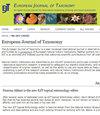Revision of the Eurybrachidae (XVII). The new Australian genus Kamabrachys gen. nov. with ten new species (Hemiptera: Fulgoromorpha)
IF 1.1
3区 生物学
Q3 ENTOMOLOGY
引用次数: 0
Abstract
The Australian genus of Eurybrachidae (Hemiptera, Fulgoromorpha) Kamabrachys gen. nov. is described to accommodate Platybrachys signata Distant, 1892 and Euronotobrachys plana Kirkaldy, 1906, the former being the type species. The new combinations Kamabrachys signata (Distant, 1892) gen. et comb. nov. and K. plana (Kirkaldy, 1906) gen. et comb. nov. are subsequently proposed. Ten new species are also included in the genus and described: K. andersoni gen. et sp. nov., K. brennani gen. et sp. nov., K. campbelli gen. et sp. nov., K. danielsi gen. et sp. nov., K. falcata gen. et sp. nov., K. fasciata gen. et sp. nov., K. pedemontana gen. et sp. nov., K. rieki gen. et sp. nov., K. v-carinatum gen. et sp. nov. and K. waineri gen. et sp. nov. The male and female genitalia of each species are illustrated and photographs of habitus, distribution maps, biological data and an identification key are provided. The mating behaviour of K. signata is described, illustrated and discussed. The genus Kamabrachys currently contains 12 species and is associated to trees in the family Myrtaceae.全翅蕨科订正(十七).澳洲Kamabrachys gen. 11 .新属及10新种(半翅目:翅蕨科)
描述了澳大利亚 Eurybrachidae(半翅目,Fulgoromorpha)Kamabrachys 新属,以容纳 Platybrachys signata Distant, 1892 和 Euronotobrachys plana Kirkaldy, 1906,前者为模式种。和 K. plana (Kirkaldy, 1906) gen.10 个新种也被列入该属并进行了描述:K. andersoni gen、K. fasciata gen. et sp. nov.、K. pedemontana gen. et sp. nov.、K. rieki gen. et sp. nov.、K. v-carinatum gen. et sp. nov.和 K. waineri gen. et sp. nov.。图文并茂地展示了每个物种的雄性和雌性生殖器,并提供了习性照片、分布图、生物数据和识别钥匙。对 K. signata 的交配行为进行了描述、说明和讨论。Kamabrachys 属目前有 12 个种,与桃金娘科的树木有关。
本文章由计算机程序翻译,如有差异,请以英文原文为准。
求助全文
约1分钟内获得全文
求助全文
来源期刊

European journal of taxonomy
ZOOLOGY-
CiteScore
2.30
自引率
8.30%
发文量
173
审稿时长
29 weeks
期刊介绍:
EJT is a fully refereed, international, fully electronic Open Access journal in descriptive taxonomy, covering subjects in zoology, entomology, botany (in its broadest sense), and palaeontology. EJT-papers must be original and adhere to high scientific (content) and technical (language, artwork, etc.) standards. Manuscripts that are clearly substandard in either of these categories will not be sent out for review. EJT is supported by a consortium of European Natural History Institutes, but its scope is global. Both authorship and geographical region of study need not be European. Authors are, however, strongly encouraged to involve European Natural History collections by consulting material or by depositing specimens (e.g. types and figured material) related to their published paper in the collection of a European Natural History Institute.
 求助内容:
求助内容: 应助结果提醒方式:
应助结果提醒方式:


